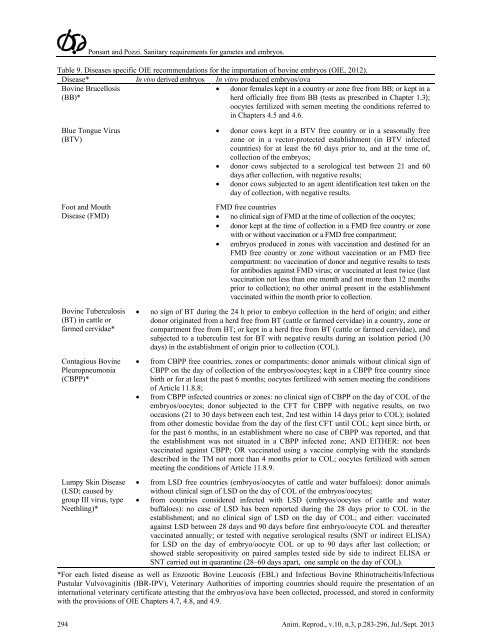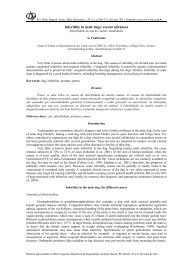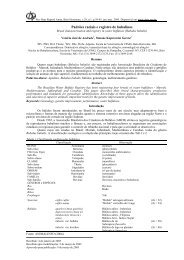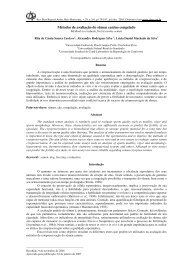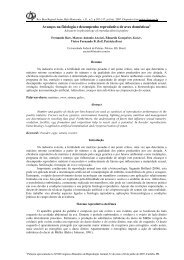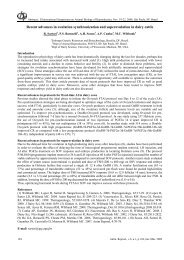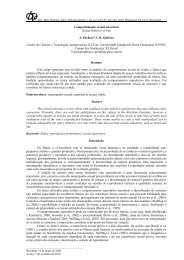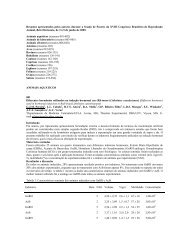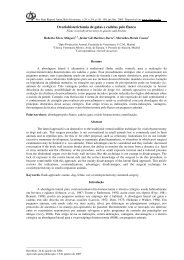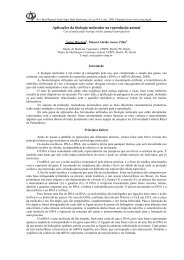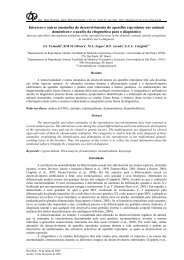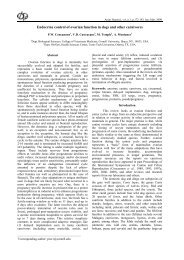Sanitary requirements for bovine gametes and embryos in ... - CBRA
Sanitary requirements for bovine gametes and embryos in ... - CBRA
Sanitary requirements for bovine gametes and embryos in ... - CBRA
Create successful ePaper yourself
Turn your PDF publications into a flip-book with our unique Google optimized e-Paper software.
Ponsart <strong>and</strong> Pozzi. <strong>Sanitary</strong> <strong>requirements</strong> <strong>for</strong> <strong>gametes</strong> <strong>and</strong> <strong>embryos</strong>.Table 9. Diseases specific OIE recommendations <strong>for</strong> the importation of <strong>bov<strong>in</strong>e</strong> <strong>embryos</strong> (OIE, 2012).Disease* In vivo derived <strong>embryos</strong> In vitro produced <strong>embryos</strong>/ovaBov<strong>in</strong>e Brucellosis(BB)*• donor females kept <strong>in</strong> a country or zone free from BB; or kept <strong>in</strong> aherd officially free from BB (tests as prescribed <strong>in</strong> Chapter 1.3);oocytes fertilized with semen meet<strong>in</strong>g the conditions referred to<strong>in</strong> Chapters 4.5 <strong>and</strong> 4.6.Blue Tongue Virus(BTV)Foot <strong>and</strong> MouthDisease (FMD)Bov<strong>in</strong>e Tuberculosis(BT) <strong>in</strong> cattle orfarmed cervidae*Contagious Bov<strong>in</strong>ePleuropneumonia(CBPP)*Lumpy Sk<strong>in</strong> Disease(LSD; caused bygroup III virus, typeNeethl<strong>in</strong>g)*• donor cows kept <strong>in</strong> a BTV free country or <strong>in</strong> a seasonally freezone or <strong>in</strong> a vector-protected establishment (<strong>in</strong> BTV <strong>in</strong>fectedcountries) <strong>for</strong> at least the 60 days prior to, <strong>and</strong> at the time of,collection of the <strong>embryos</strong>;• donor cows subjected to a serological test between 21 <strong>and</strong> 60days after collection, with negative results;• donor cows subjected to an agent identification test taken on theday of collection, with negative results.FMD free countries• no cl<strong>in</strong>ical sign of FMD at the time of collection of the oocytes;• donor kept at the time of collection <strong>in</strong> a FMD free country or zonewith or without vacc<strong>in</strong>ation or a FMD free compartment;• <strong>embryos</strong> produced <strong>in</strong> zones with vacc<strong>in</strong>ation <strong>and</strong> dest<strong>in</strong>ed <strong>for</strong> anFMD free country or zone without vacc<strong>in</strong>ation or an FMD freecompartment: no vacc<strong>in</strong>ation of donor <strong>and</strong> negative results to tests<strong>for</strong> antibodies aga<strong>in</strong>st FMD virus; or vacc<strong>in</strong>ated at least twice (lastvacc<strong>in</strong>ation not less than one month <strong>and</strong> not more than 12 monthsprior to collection); no other animal present <strong>in</strong> the establishmentvacc<strong>in</strong>ated with<strong>in</strong> the month prior to collection.• no sign of BT dur<strong>in</strong>g the 24 h prior to embryo collection <strong>in</strong> the herd of orig<strong>in</strong>; <strong>and</strong> eitherdonor orig<strong>in</strong>ated from a herd free from BT (cattle or farmed cervidae) <strong>in</strong> a country, zone orcompartment free from BT; or kept <strong>in</strong> a herd free from BT (cattle or farmed cervidae), <strong>and</strong>subjected to a tubercul<strong>in</strong> test <strong>for</strong> BT with negative results dur<strong>in</strong>g an isolation period (30days) <strong>in</strong> the establishment of orig<strong>in</strong> prior to collection (COL).• from CBPP free countries, zones or compartments: donor animals without cl<strong>in</strong>ical sign ofCBPP on the day of collection of the <strong>embryos</strong>/oocytes; kept <strong>in</strong> a CBPP free country s<strong>in</strong>cebirth or <strong>for</strong> at least the past 6 months; oocytes fertilized with semen meet<strong>in</strong>g the conditionsof Article 11.8.8;• from CBPP <strong>in</strong>fected countries or zones: no cl<strong>in</strong>ical sign of CBPP on the day of COL of the<strong>embryos</strong>/oocytes; donor subjected to the CFT <strong>for</strong> CBPP with negative results, on twooccasions (21 to 30 days between each test, 2nd test with<strong>in</strong> 14 days prior to COL); isolatedfrom other domestic bovidae from the day of the first CFT until COL; kept s<strong>in</strong>ce birth, or<strong>for</strong> the past 6 months, <strong>in</strong> an establishment where no case of CBPP was reported, <strong>and</strong> thatthe establishment was not situated <strong>in</strong> a CBPP <strong>in</strong>fected zone; AND EITHER: not beenvacc<strong>in</strong>ated aga<strong>in</strong>st CBPP; OR vacc<strong>in</strong>ated us<strong>in</strong>g a vacc<strong>in</strong>e comply<strong>in</strong>g with the st<strong>and</strong>ardsdescribed <strong>in</strong> the TM not more than 4 months prior to COL; oocytes fertilized with semenmeet<strong>in</strong>g the conditions of Article 11.8.9.• from LSD free countries (<strong>embryos</strong>/oocytes of cattle <strong>and</strong> water buffaloes): donor animalswithout cl<strong>in</strong>ical sign of LSD on the day of COL of the <strong>embryos</strong>/oocytes;• from countries considered <strong>in</strong>fected with LSD (<strong>embryos</strong>/oocytes of cattle <strong>and</strong> waterbuffaloes): no case of LSD has been reported dur<strong>in</strong>g the 28 days prior to COL <strong>in</strong> theestablishment; <strong>and</strong> no cl<strong>in</strong>ical sign of LSD on the day of COL; <strong>and</strong> either: vacc<strong>in</strong>atedaga<strong>in</strong>st LSD between 28 days <strong>and</strong> 90 days be<strong>for</strong>e first embryo/oocyte COL <strong>and</strong> thereaftervacc<strong>in</strong>ated annually; or tested with negative serological results (SNT or <strong>in</strong>direct ELISA)<strong>for</strong> LSD on the day of embryo/oocyte COL or up to 90 days after last collection; orshowed stable seropositivity on paired samples tested side by side to <strong>in</strong>direct ELISA orSNT carried out <strong>in</strong> quarant<strong>in</strong>e (28–60 days apart, one sample on the day of COL).*For each listed disease as well as Enzootic Bov<strong>in</strong>e Leucosis (EBL) <strong>and</strong> Infectious Bov<strong>in</strong>e Rh<strong>in</strong>otracheitis/InfectiousPustular Vulvovag<strong>in</strong>itis (IBR-IPV), Veter<strong>in</strong>ary Authorities of import<strong>in</strong>g countries should require the presentation of an<strong>in</strong>ternational veter<strong>in</strong>ary certificate attest<strong>in</strong>g that the <strong>embryos</strong>/ova have been collected, processed, <strong>and</strong> stored <strong>in</strong> con<strong>for</strong>mitywith the provisions of OIE Chapters 4.7, 4.8, <strong>and</strong> 4.9.294 Anim. Reprod., v.10, n.3, p.283-296, Jul./Sept. 2013


